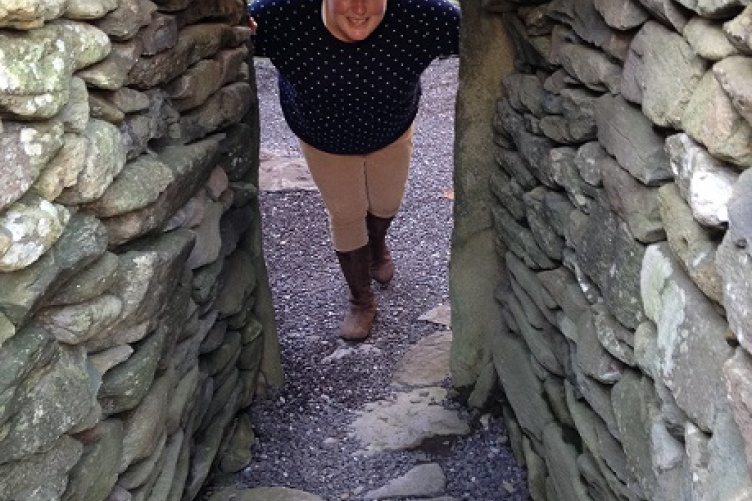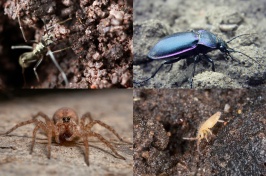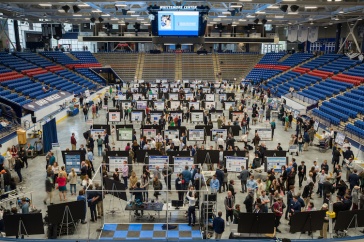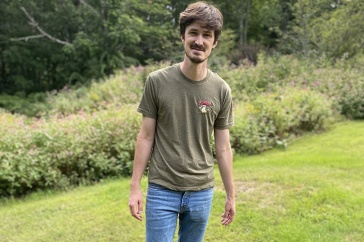
Professor Howey's term as James H. Hayes and Claire Short Hayes Professor of the Humanities will run from fall 2016 to spring 2021. The Hayes Chair was established to be a focal point for research and teaching on New Hampshire's history, culture and government. We asked Professor Howey a few questions about the work she will be doing over the next five years in her Hayes Chair project, A Deep Time, Multi-Archive Narrative of the Anthropocene in the Great Bay.
Q: Your project focuses on a geological epoch defined as “the Anthropocene.” For those who may not be familiar with that term, can you define it?
A: While it has not been formally designated yet as a geologic epoch, many scientists agree that given the major impact of human activities on earth and atmosphere, we are living in the Anthropocene, a human-dominated geological epoch supplementing the Holocene. This means humans are not just biological agents but geologic agents, which is a pretty profound thing to think about.
Q: What inspired you to work on this topic?
A: One of my long standing research interests as an archaeologist has been the materialization of the dialectical relationship between people and their landscapes-- how individuals inhabit landscape and it inhabits them. Doing geospatial analyses to look at past landscapes, I started working more closely with natural scientists, where these methods are more developed. While originally I began working with natural scientists for methodological reasons, this quickly turned to broader topical/theoretical interests. My research has increasingly focused on collaborating with natural scientists to look at ecosystem conditions within the context of the long and variable history of human population influence and to use these deep-time perspectives to improve our understanding of current anthropogenic change. The Anthropocene is an emergent concept or frame that encapsulates these ideas and emphasizes the permanency of the human impact on the earth. This frame, though, needs more theorizing and research by humanists and social scientists. Beyond trying to isolate when, we must also be asking what social, economic, and ideological processes led to our current state of dominant, potentially catastrophic, impact on the earth. How did past societies perceive, or fail to perceive, their impact on the natural world and how did this affect their quality of life? How do such historical trajectories inform us and ecosystems today? My interest in the Great Bay Estuary actually grew out of developing and teaching the undergraduate course ANTH 444: The Lost Campus: The Archaeology of UNH. It was the archival, survey, and excavation research done by students on the cultural heritage of UNH, both on central campus and its property in other parts of Great Bay, that got me excited about the Great Bay landscape.
Q: You’ve talked about “a new conceptual reality, one in which human history and natural history are merged.” What do you see being the most surprising way we are going to grapple with this new reality in coming decades and centuries?
A: There are of course the physical ways we are going to have to, whether we like it or not, grapple with the outcomes of our irreversible impact on our earth and atmosphere, including things like floods and droughts, severe storms, sea-level rise, species extinctions, increased heat stress (most of us are well familiar with these things). These physical realities come with social ones as well, like climate refugees, migrations, heightened hostility over limited resources, as well as less significant but still meaningful social changes, like, for instance, the loss of skiing and hockey as part of New England life. But more than just these tangible changes, we are going to have to grapple with the philosophical weight of the fact that we moved from biological agents to geological agents, that we, through our actions, are now irrevocably responsible for the future of the earth. This is indeed a new conceptual reality, and I think, to begin to understand it, scholars of all kinds are going to commit to doing a new kind of work that is fundamentally interdisciplinary if not trans-disciplinary.
Q: You plan to create a deep-time and multi-archival approach to writing a history of this epoch. Can you describe a little of what that will entail over the next several years?
A: I will conduct archaeological survey, excavation, collections analysis, and archival research on Precontact (ca. 9500 BC to 1600 AD) and Historic period (ca. 1600 to 1900 AD) occupation in the Great Bay Estuary to understand historical cycles of resource decisions, depletions, and capacities for cultural and ecological resilience and the lessons these hold for broader conversations about our ongoing transformation of the natural world in the Anthropocene. The Great Bay has seen relatively little systematic archaeological research and so one of the most time intensive but critical of my activities as Hayes chair will be the thorough archaeological survey of the Great Bay watershed in New Hampshire. In order to establish a strong sense of the distribution and nature of precontact and historic settlement here, I will spend three summer field seasons working with students, community volunteers, and tribal consultants to complete this survey.
Q: What makes the Great Bay an especially compelling ecological feature to analyze?
A: Estuaries, in general, are highly sensitive ecosystems that provide “first alarm” indicators about the combined effects of non-climatic human activities and anthropogenic climatic stressors on coastal ecosystems. The Great Bay Estuary is the single largest estuarine system on the Gulf of Maine and one of the most complex and recessed embayments found on all of the Atlantic Ocean. The interlocking forest-river-estuary-coastal environments that come together in the Great Bay Estuary system as well as the Estuary’s combination of five internal habitats (eelgrass habitat, mudflat habitat, salt marsh habitat, subtitdal habitat, and rocky intertidal habitat) makes it a particularly important bellwether of anthropogenic ecosystem change. It is really fortuitous that UNH falls in the Great Bay Estuary!
Q: Can you talk a little bit about what it’s like, as an anthropological archaeologist, to get the opportunity to work with both humanists and scientists? How do you bring together those perspectives?
A: This is an exciting aspect of my Hayes chair, to bring together humanists and natural scientists to tell the story of the Anthropocence, a story no discipline can tell alone. And, indeed, as I mentioned above, I have begun doing this kind of cross-disciplinary work tracking between archaeological data, historic/archival data, and the natural sciences. The archaeological record holds a whole suite of proxy data that can be harnessed to track socio-natural systems and anthropogenic landscapes over time. Key proxy data consist of a) settlement patterns; b) culturally modified artifacts (ceramics, stone tools) and features (e.g., hearths, houses), and c) the ecofacts or detritus of everyday life (plant remains, animal bones and shells, anthroposols and sediments) that humans accumulated and discarded, often at surprisingly high rates. So, as an archaeologist, there is much opportunity to do this kind of work, and, indeed, I have found an incredible openness among natural scientists to bring in this human and deep-time component to their work. This has made developing ideas for interdisciplinary collaborations very robust and exciting. As to how you bring together those perspectives, the nuts-and-bolts of doing it is really hard. We work at different scales--scale is really a big issue. What I think is enough data to say something is very different than what a geneticist or a landscape ecologist thinks. So, building bridges between different data sets is hard work, to bring them together into one narrative is really hard work. I think it takes creativity, openness, and then also acceptance that some gaps will always remain on the part of all involved, but if we don’t do it because it is hard and because there will be imperfections, we will fail to grasp the fullness of what the Anthropocene actually means.
Q: How does GPS/ArcGIS technology help you conduct your research?
A: One particularly exciting way I will be incorporating these technologies into my project is through the use of ArcCollector run on smart phones to create a crowd-sourced means of collecting archaeological site survey data. I will be able to invite any volunteer on the project into the project database (housed in ArcGIS Online) and they will be able to collect data on their individual phones (and this will be automatically linked to the project database). Rather than expensive GPS equipment that might be daunting to use or make volunteers feel intimidated, this will put the research directly into their hands, which is an exciting prospect. By centralizing the project database in ArcGIS Online, I and students involved in the project (and even volunteers) will be able to share our findings with the public through web-based Story Maps easily created using ArcGIS Online (of course exact site locations will be kept secure to ensure sites are not looted). In this project I am excited to use geospatial technologies to make data collection and dissemination more accessible to students and the broader public.
Q: How is this project important to enriching our understanding of New Hampshire’s culture and history?
A: Humans have had a long and variable presence in the Great Bay Estuary, a presence tied in many ways and throughout every period of occupation, to the natural resource base of this system. Through this Hayes project, I will deepen the understanding of Great Bay’s distinctly socioecological history and share what I find about this important aspect of New Hampshire’s story with other scholars, students, and the public. Through this work, I aim to foreground New Hampshire’s culture and history in the development of new understandings of the long-term and richly complex role played by human societies in altering the earth’s biosphere.
















































